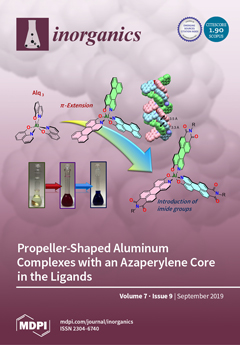Tetradentate N
2S
2 ligands (such as bismercaptoethanediazacycloheptane in this study) have seen extensive use in combination with transition metals. Well-oriented N
2S
2 binding sites are ideal for d
8 transition metals with square planar preferences, especially Ni
II, but also as a square pyramidal base for those metals with pentacoordinate preferences, such as [V≡O]
2+, [Fe(NO)]
2+, and [Co(NO)]
2+. Further reactivity at the thiolate sulfurs generates diverse bi, tri, and tetra/heterometallic compounds. Few N
2S
2 ligands have been explored to investigate the possibility of binding to main group metals, especially group III (M
III) metals, and their utility as synthons for main group/transition metal bimetallic complexes. To open up this area of chemistry, we synthesized three new five-coordinate main group XMN
2S
2 complexes with methyl as the fifth binding ligand for M = Al, and chloride for M = Ga and In. The seven-membered diazacycle, dach, was engaged as a rigid stabilized connector between the terminal thiolate sulfurs. The pentacoordinate XMN
2S
2 complexes were characterized by
1H-NMR,
13C-NMR,
+ESI-Mass spectra, and X-ray diffraction. Their stabilities and reactivities were probed by adding Ni
II sources and W(CO)
5(THF). The former replaces the main group metals in all cases in the N
2S
2 coordination environment, demonstrating the weak coordinate bonds of M
III–N/S. The reaction of XMN
2S
2 (XM = ClGa
III or ClIn
III) with the labile ligand W(0) complex W(CO)
5(THF) resulted in Ga/In–W bimetallic complexes with a thiolate S-bridge. The synthesis of XMN
2S
2 complexes provide examples of M
III–S coordination, especially Al–S, which is relatively rare. The bimetallic Ga/In–S–W complex formation indicates that the nucleophilic ability of sulfur is retained in M
III–S–R, resulting in the ability of main group M
III–N
2S
2 complexes to serve as metalloligands.
Full article





